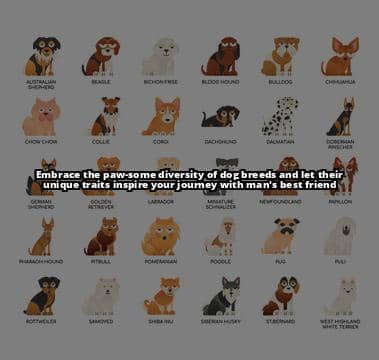Unveiling Diverse Types of Dogs: Your Ultimate Dog Breed Guide
Learn about Different Types of Dogs
- Different dog breed classifications: Small, medium, large, working, companion, specialized, short-haired, long-haired, and hypoallergenic.
- Popular and rare dog breeds: Overview of globally recognized breeds and exploration of unique lesser-known breeds.
- Factors to consider in choosing a dog breed: Activity levels, grooming needs, living space, temperament, and compatibility.
“Type of dogs” refers to the distinct varieties of dogs that exist based on their breeds, characteristics, and purposes. Dogs have earned the title of man’s best friend for their unwavering loyalty and companionship. Understanding the various types of dogs based on their breeds is essential for prospective dog owners to make informed decisions that align with their lifestyle and preferences.
Definition and Importance of Understanding Dog Breeds
Dog breeds represent different types of dogs that have been selectively bred over generations for specific traits and functions. Each breed possesses unique physical and behavioral characteristics that set them apart from one another. Understanding dog breeds is crucial as it aids in selecting a dog that suits your personality, activity level, living circumstances, and caregiving capabilities.

Overview of the Various Types of Dogs Based on Breed Characteristics
Dog breeds can be categorized into different groups based on criteria such as size, purpose, and coat type. Each classification sheds light on the diverse roles dogs fulfill in human lives, from working alongside individuals to offering companionship and support.
Classification of Dog Types
Size-based Classification
| Classification | Description | Examples |
|---|---|---|
| Size-based | Categorizes dogs based on their size, ranging from small to medium to large breeds. | Chihuahua, Bulldog, German Shepherd |
| Purpose-based | Groups dogs according to their intended purpose or function, including working, companion, and specialized roles. | Siberian Husky, Poodle, Beagle |
| Coat-based | Classifies dogs based on their coat length and maintenance requirements, such as short-haired, long-haired, and hypoallergenic breeds. | Dalmatian, Afghan Hound, Poodle |
1. Small Dog Breeds
Small dog breeds, also known as toy breeds, are typically compact in size and are well-suited for apartment dwellers or those with limited living space. Examples include the Chihuahua, Pomeranian, and Yorkshire Terrier.
2. Medium Dog Breeds
Medium-sized dogs strike a balance between small and large breeds, offering sturdiness combined with a manageable size. Breeds like the Bulldog, Cocker Spaniel, and Border Collie fall into this category.
3. Large Dog Breeds
Large dog breeds are known for their impressive stature and strength, making them suitable for tasks such as guarding, herding, or pulling carts. Popular large breeds include the German Shepherd, Labrador Retriever, and Golden Retriever.
Purpose-based Classification
1. Working Dogs
Working dogs are bred for specific tasks such as herding livestock, guarding property, or assisting people with disabilities. Breeds like the Siberian Husky, Boxer, and Doberman Pinscher excel in roles requiring intelligence, strength, and loyalty.
2. Companion Dogs
Companion dogs, also known as lap dogs or toy breeds, are primarily kept for their affectionate nature and companionship. Breeds like the Poodle, Shih Tzu, and Maltese thrive on human interaction and make excellent family pets.
3. Specialized Dogs (e.g., hunting, herding)
Specialized dogs are bred for particular skills such as hunting game, herding livestock, or performing search and rescue operations. Breeds like the Beagle, Australian Shepherd, and Bloodhound exhibit exceptional abilities that align with their intended purposes.
Coat-based Classification
1. Short-haired Dog Breeds
Short-haired dog breeds have coats that are easy to maintain and require minimal grooming. Breeds like the Dalmatian, Great Dane, and Boxer have sleek coats that shed less and are suitable for owners with busy lifestyles.
2. Long-haired Dog Breeds
Long-haired dog breeds boast luxurious coats that demand regular grooming to prevent matting and tangles. Breeds like the Afghan Hound, Shih Tzu, and Maltese showcase flowing locks that add to their aesthetic appeal but necessitate dedicated grooming efforts.
3. Hypoallergenic Dog Breeds
Hypoallergenic dog breeds are ideal for individuals with allergies as they produce less dander and shed minimally. Breeds like the Poodle, Bichon Frise, and Portuguese Water Dog are popular choices for allergy sufferers seeking canine companionship.

Popular Dog Breeds
Overview of Globally Recognized and Beloved Dog Breeds
Many dog breeds have earned worldwide acclaim for their endearing qualities and versatility. From the loyal Labrador Retriever to the spirited German Shepherd, popular breeds capture the hearts of dog enthusiasts worldwide.
Characteristics, Temperaments, and Care Requirements of Popular Breeds
Popular dog breeds exhibit a range of characteristics, from intelligence and obedience to playfulness and loyalty. Understanding the temperaments and care needs of popular breeds like the French Bulldog, Beagle, and Dachshund is essential for providing them with a happy and fulfilling life.

Rare and Uncommon Dog Breeds
Exploration of Lesser-known and Unique Dog Breeds
While popular breeds often dominate the spotlight, lesser-known dog breeds offer novelty and intrigue. Discovering rare breeds like the Xoloitzcuintli, Norwegian Lundehund, and Azawakh unveils the diversity and richness of the canine world.
Highlighting Distinctive Traits and Qualities of Lesser-known Breeds
Rare and uncommon dog breeds possess unique traits that distinguish them from more mainstream counterparts. Whether it’s the unusual appearance of the Bergamasco Shepherd or the ancient lineage of the Thai Ridgeback, lesser-known breeds bring a sense of wonder and fascination to the world of dogs.
Factors in Choosing a Dog Breed
Considerations for Selecting the Right Dog Breed
Choosing a dog breed requires careful consideration of various factors to ensure a harmonious match between the dog and its owner.
1. Activity Levels and Exercise Requirements
Different dog breeds have varying energy levels and exercise needs. Active breeds like the Border Collie and Australian Shepherd thrive on mental and physical stimulation, while calmer breeds like the Bulldog and Basset Hound are content with moderate exercise.
2. Grooming Needs and Maintenance
Grooming demands vary among dog breeds, with some requiring regular brushing, trimming, and bathing to maintain coat health. Understanding the grooming requirements of breeds like the Poodle and Shih Tzu is vital for keeping them looking their best.
3. Living Space and Environment Suitability
The size and energy level of a dog breed should align with the available living space to ensure a comfortable coexistence. Apartment-friendly breeds like the Cavalier King Charles Spaniel and Pug adapt well to confined spaces, while larger breeds like the Great Dane and Saint Bernard may thrive in spacious homes with ample outdoor access.
4. Temperament and Compatibility with Family
Each dog breed has unique temperament traits that influence its compatibility with different family dynamics. Breeds like the Golden Retriever and Labrador Retriever are known for their friendly and sociable nature, making them excellent choices for families with children, while breeds like the Chow Chow and Akita exhibit more aloof tendencies that may suit experienced dog owners.
Importance of Research and Understanding Breed-specific Characteristics
Conducting thorough research on dog breeds and their specific traits is crucial for making an informed decision when selecting a canine companion. By understanding breed-specific characteristics, tendencies, and care requirements, prospective dog owners can ensure a harmonious and fulfilling relationship with their new furry friend.
Real-Life Example: Finding the Perfect Companion
Meet Sarah and Max
Sarah, a young professional living in the city, was looking to adopt a dog that would fit well with her active lifestyle. After considering various factors like her apartment size, exercise routine, and preference for a medium-sized dog, she decided to adopt Max, a friendly Australian Shepherd mix.
Max’s energy level and intelligence matched Sarah’s need for a companion to join her on runs in the park and outdoor adventures. His loving and loyal nature also made him a perfect fit for Sarah’s desire for a furry friend to come home to after a long day at work.
Sarah’s experience in finding the ideal companion in Max highlights the importance of considering lifestyle and preferences when choosing a dog breed. By understanding her needs and conducting thorough research on different breeds, Sarah was able to find a four-legged friend who brought joy, companionship, and endless love into her life.

Mixed Breed Dogs
Growing Trend and Appeal of Mixed Breed Dogs
Mixed breed dogs, often referred to as mutts or designer dogs, are gaining popularity for their unique looks and diverse genetic backgrounds. Combining the traits of two or more breeds, mixed breed dogs offer a blend of characteristics that make them one-of-a-kind companions.
Advantages and Considerations of Adopting a Mixed Breed Dog
Adopting a mixed breed dog comes with various advantages, including potentially lower susceptibility to breed-specific health issues and a broader gene pool that may enhance overall health and vitality. However, it’s essential to consider the unpredictable nature of mixed breed traits and the potential for varying temperaments and care needs when welcoming a mixed breed into your home.
Resources for Further Exploration
Links to Reputable Sources for In-depth Information on Dog Breeds
For those seeking more detailed information on specific dog breeds, reputable online sources such as PetPawwy offer comprehensive insights into breed characteristics, care requirements, and historical backgrounds.
Recommended Reading Materials, Websites, and Organizations Focusing on Dog Types
Exploring books, websites, and organizations dedicated to dog breeds can provide valuable knowledge and guidance for prospective dog owners. Resources like the American Kennel Club (AKC) and breed-specific clubs offer a wealth of information on breed standards, training tips, and health considerations for various dog breeds.
Conclusion
Encouragement to Match Dog Type with Lifestyle and Preferences
Selecting the right dog breed is a significant decision that requires thoughtful consideration and research. By matching the characteristics and needs of a dog breed with your lifestyle and preferences, you can cultivate a strong and rewarding bond with your canine companion.
Questions & Answers
Q. What are some popular types of dogs for families?
A. Golden Retrievers, Labrador Retrievers, and Beagles are popular choices for families due to their friendly and gentle nature.
Q. How can I choose the right type of dog for my lifestyle?
A. Consider your activity level, living space, and time commitment when selecting a dog breed that matches your lifestyle.
Q. Who should consider adopting a smaller breed of dog?
A. Individuals living in apartments or smaller homes may benefit from adopting smaller breeds like Chihuahuas or French Bulldogs.
Q. What if I have allergies but still want a dog?
A. Hypoallergenic breeds such as Poodles, Bichon Frises, and Portuguese Water Dogs are suitable for individuals with allergies.
Q. How can I ensure I’m choosing a reputable breeder for a specific type of dog?
A. Research breeders, ask for references, visit their facilities, and ensure they prioritize the health and well-being of their dogs.
Q. What if I prefer a specific type of dog that is not suitable for my living situation?
A. Consider alternative options such as volunteering at a local shelter, fostering dogs, or exploring breeds that are better suited to your living conditions.




Leave a Reply